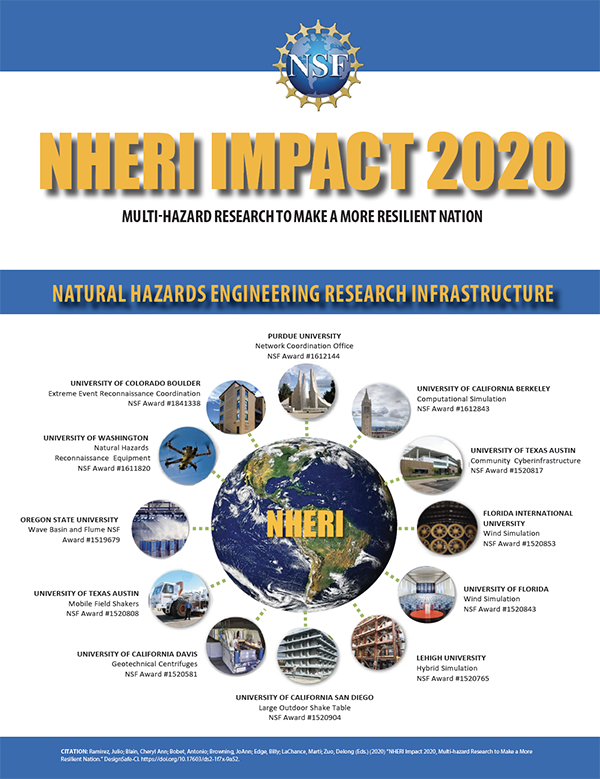FOR IMMEDIATE RELEASE
NHERI publishes milestone research collection

Articles in NHERI Impact 2020 describe powerful NSF-funded research in natural hazards engineering
West Lafayette, IN, Nov. 3, 2020 The Natural Hazards Engineering Research Infrastructure network, NHERI, has published a new book, NHERI Impact 2020, a 70-page collection of illustrated articles detailing research in the field of natural hazards engineering. The book features a wide range of NSF-funded projects that will mitigate structural and societal damage from earthquakes, hurricanes and windstorms, storm surge, flooding and tsunami waves.
This publication provides a sampling of the broad impact made possible through NHERI facilities. To date, researchers, students, educators and practitioners have collaborated on nearly 100 multi-year, multi-investigator projects funded by NSF and other sources.
The 12-node, shared-use NHERI network comprises world-class experimental facilities, a cyberinfrastructure, a simulation hub, a RAPID reconnaissance facility, a social science and cross-disciplinary rapid response disaster research hub, and a network coordination office.
Researchers from across the nation leverage NHERI facilities to perform unique testing and numerical simulations focused on reducing the impact from natural hazards. Topics within NHERI Impact 2020 include centrifuge, wind tunnel, shake table and real-time hybrid simulation testing; soil behavior; wind and tsunami wave behavior; non-destructive infrastructure testing; post-disaster reconnaissance; and simulation software tools.
DesignSafe is the NSF-funded repository for natural hazards data, for both curation and publishing. It serves as NHERIs hub for training, education and outreach. The NHERI Impact 2020 publication is downloadable from the DesignSafe website, NHERIs cyber platform for collaboration.
In a recent interview, NHERI NCO Director Julio Ramirez stated: The NHERI Impact 2020 book is inspirational not just for researchers, but for anyone interested in the welfare of our society. The research projects in this work illustrate that natural hazards researchers are dedicated to preserving our nations infrastructure, economy and social well-being.
Ramirez suggested that researchers and practitioners who appreciate the NHERI Impact 2020 book will also gain insight on possible research from reading the NHERI Science Plan. Released in January 2020, NHERIs Science Plan provides a roadmap for the next five years of NSF-funded natural hazards research.
The NHERI Impact 2020 book is a follow-up to a previous work, NEES 2004-2014: A Decade of Earthquake Engineering Research, which presents dozens of high-impact, NSF-funded research projects in earthquake engineering.
For details about NHERI, its experimental facilities, cyberinfrastructure, and other network components, visit designsafe-ci.org.
Media contacts:
Julio Ramirez, PhD
Director, NHERI Network Coordination Office
Karl H. Kettelhut Professor in Civil Engineering
Lyles School of Civil Engineering
Purdue University
Email: ramirez@purdue.edu
About NHERI
The Natural Hazards Engineering Research Infrastructure, NHERI, is an 11-node network of shared-use experimental facilities and centers. NHERI researchers are dedicated to reducing damage and loss-of-life due to natural hazards such as earthquakes, windstorms, tsunamis and storm surge. NHERIs DesignSafe Cyberinfrastructure provides the engineering and social science communities with state-of-the-art computing resources needed to meet the research challenges of the 21st century. NHERI is supported by multiple grants from the National Science Foundation, including the Network Coordination Office, #1612144, and the DesignSafe-CI, #1520817.
About the National Science Foundation
The U.S. National Science Foundation propels the nation forward by advancing fundamental research in all fields of science and engineering. NSF supports research and people by providing facilities, instruments and funding to support their ingenuity and sustain the U.S. as a global leader in research and innovation. With a fiscal year 2020 budget of $8.3 billion, NSF funds reach all 50 states through grants to nearly 2,000 colleges, universities and institutions. Each year, NSF receives more than 40,000 competitive proposals and makes about 11,000 new awards. Those awards include support for cooperative research with industry, Arctic and Antarctic research and operations, and U.S. participation in international scientific efforts.







